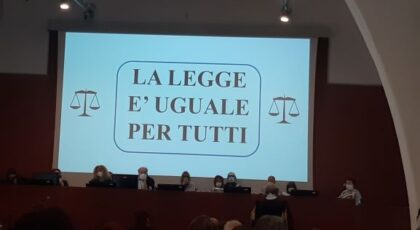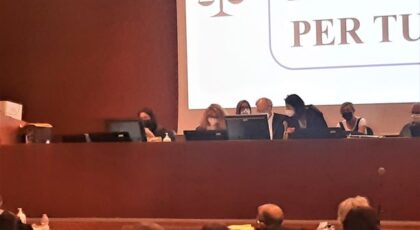Quello che segue (con traduzione in inglese) è un articolo del magistrato Raffaele Guariniello, pubblicato il 16 giugno 2023 sulla testata online «Italia Libera»
RAFFAELE GUARINIELLO
Non tocca certo a me dire che il processo Eternit bis costituisce “una pietra miliare sulla strada per i diritti”, e che “l’Italia è l’unico Paese al mondo in cui si fanno cause come queste”. Mi pongo, invece, alcune domande. Ecco la prima: stiamo assistendo allo sviluppo di una nuova tendenza nella giurisprudenza dei Tribunali e delle Corti d’Appello in tema di tumori professionali? Il fatto è che, su questo fronte (e, segnatamente, a proposito dei tumori asbesto-correlati), la Sezione Quarta della Corte di Cassazione – dopo aver confermato per oltre vent’anni una condanna dopo l’altra – dal 2016 non è stata più così implacabile. E non perché fosse in discussione il nesso amianto-mesotelioma, ma perché nella comunità scientifica non si sarebbe formato un sufficiente consenso con riguardo al c.d. effetto acceleratore delle esposizioni successive a quelle che hanno determinato l’insorgenza del processo patogenetico. Con una conseguenza: che i soggetti imputati nei procedimenti penali per tumori da amianto hanno spesso gestito l’azienda incriminata solo per una parte del periodo in cui i lavoratori colpiti da tumore sono stati esposti all’agente cancerogeno presso quell’azienda. Ecco quindi che, a propria discolpa, gli imputati sostengono che non è conosciuta la data di effettiva insorgenza delle patologie. E perciò, non essendo accertata la data di effettiva insorgenza delle patologie, le morti non potrebbero attribuirsi ad essi. Di qui numerose, conformi sentenze della Sezione Quarta che non affermano la responsabilità di aziende situate in diversi parti del nostro Paese: ad esempio, uno stabilimento industriale per morti e malattie patite da ventisette lavoratori; un’industria meccanica-elettromeccanica per trentaquattro dipendenti deceduti trentatré per mesotelioma pleurico e uno per adenocarcinoma polmonare; uno stabilimento petrolchimico per lavoratori deceduti per mesotelioma o tumore polmonare; un’acciaieria per sedici lavoratori esposti a una miscela di elementi dannosi per la salute costituita da acidi tossici, apirolo, diossina, amianto, polveri sottili e sottilissime, carbone, silice, ferro, Ipa, metalli pesanti, solidi e inerti, PCB, mercurio, anidride carbonica e fibrosanti e altri quindici esposti ad amianto con un ulteriore risultato: quello di produrre smarrimento tra i Pubblici Ministeri e i Giudici di merito.
Tra il 2022 e il 2023, tuttavia, hanno destato interesse, in particolare, sei pronunce di condanna che sembrano segnare una ripresa giurisprudenziale: Tribunale di Avellino 28 gennaio 2022; Tribunale di Palermo 12 aprile 2022; Corte d’Appello di Venezia 21 giugno 2022; Corte d’Assise di Napoli 22 giugno 2022; Corte d’Appello di Torino 2 maggio 2023; e ora appunto Corte d’Assise di Novara 7 giugno 2023. Una ripresa giurisprudenziale che a ben vedere si sviluppa sull’onda delle sentenze emesse in materia da un’altra Sezione della Cassazione, la Sezione Terza, ove si affaccia un orientamento contrastante con le attuali impostazioni della Sezione Quarta e, invece, coerenti piuttosto con la giurisprudenza della stessa Sezione Quarta dei precedenti vent’anni. Quella giurisprudenza secondo cui la colpa per le morti da amianto deve essere attribuita egualmente alle condotte omissive dei vari responsabili della gestione aziendale susseguitisi nel tempo, anche se per una parte soltanto del periodo di esposizione delle vittime, in quanto tali condotte riducono i tempi di latenza della malattia nel caso di patologie già insorte, oppure ne accelerano i tempi di insorgenza nel caso di patologie insorte successivamente.
Ecco, quindi, una seconda domanda: sino a quando dovremo assistere al fenomeno di due Cassazioni a proposito dei morti per tumori professionali? Ecco perché mi fa sperare un’iniziativa del tipo prospettato dalla Legge 10 maggio 2023 n. 53, istitutiva di una Commissione parlamentare di inchiesta sugli illeciti ambientali oltre che agroalimentari. Mi riferisco all’art. 1, comma 1, lettera h), che attribuisce alla Commissione anche il compito di verificare l’eventuale sussistenza di attività illecite relative alla gestione e allo smaltimento dei materiali contenenti amianto, nonché il rispetto della normativa vigente e le eventuali inadempienze da parte di soggetti pubblici e privati. Il fatto è che non si è ancora rimarginata la ferita aperta dalla disattenzione in cui è caduta la proposta di legge elaborata dalla Commissione di studio sulla riforma della normativa sull’amianto creata con D.M. 30 aprile 2019 n. 114 e avente per oggetto modifiche alle norme dettate dalla Legge 27 marzo 1992 n. 257 in tema di cessazione dell’impiego dell’amianto.
L’occasione è quanto mai propizia per porre sul tappeto alcuni dei problemi che a tutt’oggi stanno frenando la tutela delle popolazioni contro l’esposizione all’amianto. Purtroppo, non pochi dei meccanismi previsti dalle norme vigenti sono rimasti concretamente inutilizzati: sia per il rinvio a decreti ministeriali non sempre poi tempestivamente emanati, sia per la laboriosità di determinati adempimenti, sia per l’inerzia di alcuni degli organismi deputati alla realizzazione di tali adempimenti, sia per la debolezza dell’apparato sanzionatorio. Non senza contare che nel frattempo si è ulteriormente sviluppato il sapere in materia. Si pensi alla fibra anfibolica di fluoro-edenite, presente in Italia sul territorio del Comune di Biancavilla, riconosciuta dalla comunità scientifica quale causa di mesotelioma attraverso una serie di meccanismi patogenetici analoghi a quelli delle fibre d’amianto.
Si affaccia, in particolare, l’esigenza di irrobustire il regime sanzionatorio. Fa spicco, in proposito, la palese inadeguatezza dell’apparato sanzionatorio allestito a salvaguardia del divieto di estrazione, importazione, esportazione, commercializzazione di amianto, di prodotti di amianto o di prodotti contenenti amianto: una mera ammenda. Ben più efficace sarebbe la pena della reclusione e della multa, magari con previsione di un’apposita circostanza aggravante per l’ipotesi in cui datori di lavoro, dirigenti, preposti, abbiano in uno o più soggetti contribuito a determinare o ad anticipare l’insorgenza di un mesotelioma.
Allarmano poi i comportamenti tesi a depotenziare il sistema di sorveglianza epidemiologica delle patologie da amianto in Italia, sia attraverso il mancato supporto alle attività connesse alla registrazione dei mesoteliomi in alcune Regioni italiane, sia attraverso la mancata notifica all’Autorità Giudiziaria dei casi di patologia asbesto correlata, certi o sospetti. Pressante è l’esigenza di andare in tutto il Paese alla ricerca dei tumori asbesto correlati, e di evitare che restino sepolti negli archivi dei comuni e degli ospedali. Lo scopo è quello di celebrare i processi penali a carico dei responsabili e di far risarcire le vittime e i loro congiunti, ma anche quello di scoprire luoghi insospettati e insospettabili di esposizione a rischi di cancro. In questa prospettiva, appare indispensabile stabilire obblighi di comunicazione dei casi di patologie asbesto-correlate (ma in generale di tumori di sospetta origine professionale) che disancorino l’osservanza di tali obblighi da controproducenti discrezionalità e che siano assistiti da un adeguato regime sanzionatorio.
E poi i processi penali sull’amianto celebrati in questi anni hanno aperto gli occhi. Hanno fatto capire che i rischi ambientali non possono essere confinati dentro le mura delle fabbriche, ma possono espandersi in danno dell’intera comunità. Sino ad assumere le dimensioni del disastro ambientale: e, cioè, di un disastro che – a differenza di un evento come l’improvvisa piena di un torrente – può prolungarsi nel tempo per anni e anni. Non possiamo, non dobbiamo interessarci soltanto dei luoghi di lavoro. Dobbiamo occuparci anche degli ambienti di vita. Dobbiamo tutelare anche la sicurezza e la salute dei cittadini. E a questo scopo s’impone un’interpretazione autentica di norme del codice penale quali gli articoli 434, 449 e 452-quater, onde chiarire che, ai fini del decorso del termine di prescrizione del reato, il disastro ambientale s’intende consumato sino a che non ne cessino gli effetti lesivi o pericolosi per l’ambiente o per le persone, e non — come ha sostenuto la Corte di Cassazione nel primo processo Eternit — solo sino al momento in cui hanno fine le immissioni delle polveri e dei residui della lavorazione dell’amianto. © Riproduzione riservata
[Nella foto grande, il magistrato Raffaele Guariniello, circondato dai giornalisti, nell’aula del Tribunale di Torino dove si era svolto il Maxiprocesso Eternit Uno]
TRANSLATION by VICKY FRANZINETTI
Italia Libera (on line publication https://italialibera.online/)
THE ASBESTOS DISASTER AND JUSTICE: ‘MORE SURVEILLANCE, MORE SANCTIONS AND AUTHENTIC INTERPRETATION OF THE CRIMINAL CODE’
By RAFFAELE GUARINIELLO JUNE the 16th, 2023
IT IS CERTAINLY NOT for me to say that the Eternit bis trial is ‘a milestone on the road to rights’, and that ‘Italy is the only country in the world where court cases like this are held’.
Rather, I ask myself a few questions:
- i) : are we witnessing a new trend in the jurisprudence (case law) of the Courts and Courts of Appeal on occupational cancers? On this front after confirming one conviction after another for over twenty years – and, specifically, with reference to asbestos-related cancers, the Fourth Section (Circuit) of the Court of Cassation – – has been wavering since 2016. This is not due to the asbestos-mesothelioma link being questioned, but because the Court has stated there is no consensus within the scientific community on to the so-called accelerating effect of exposures subsequent to the [early] exposure(s) that determined the onset of the disease (pathogenic process). This had one result: given that the defendants in criminal proceedings for asbestos tumours often managed the incriminated company for only part of the period during which the cancer-stricken workers had been exposed to the carcinogenic agent at that company, they argue that the date of the actual onset of the diseases is not known. Therefore, since the date of actual onset of the pathologies is not certain, the deaths could not be attributed to them. As a result, there are numerous, consistent verdicts of the Fourth Section of the Court of Cassation that fail to recognize the responsibility or the liability of companies located in different parts of our country: for example, an industrial plant for deaths and illnesses suffered by twenty-seven workers; a mechanical-electromechanical industry for thirty-four employees who died thirty-three from pleural mesothelioma and one from lung adenocarcinoma; a petrochemical plant for workers who died from mesothelioma or lung cancer; a steelworks for sixteen workers exposed to a mixture of elements harmful to health consisting of toxic acids, dioxin, asbestos, fine and ultrafine dust, coal, silica, iron, PAHs, heavy metals, solids and inert materials, PCBs, mercury, and fibrosis-producing agents, and another fifteen exposed to asbestos, with a further result of producing bewilderment among prosecutors and judges of merit.
However, between 2022 and 2023 there were six verdicts that seem to mark a different case law, going back to previous approaches and that have aroused interest: the Court of Avellino 28 January 2022; the Court of Palermo 12 April 2022; the Court of Appeal of Venice 21 June 2022; the Court of Assizes of Naples 22 June 2022; the Court of Appeal of Turin 2 May 2023; and now the Court of Assizes of Novara 7 June 2023. A jurisprudential change issued in the wake of verdicts on the subject by another Section of the Supreme Court, the Third Section, whose orientation contrasts with the current settings of the Fourth Section and, instead, is consistent rather with the Fourth Section’s approach in the previous twenty years. That jurisprudence according to which fault for asbestos-related deaths is attributed equally to the omissive behaviour of the various company managers who succeeded over time, even if only for part of the period of exposure of the victims, inasmuch as such conduct reduced the latency time of the disease in the case of pathologies that had already arisen, or accelerated the onset time in the case of pathologies that arose subsequently.
- ii) why does the Court of Cassations hear cases on deaths due to occupational cancers? Here are the reasons why I am hopeful about an initiative like the one envisaged by Law No. 53 of 10 May 2023, which established a Parliamentary Commission of Inquiry into environmental and agro-food offences & crimes. I am referring to Article 1(1)(h), which also gives the Commission the task of verifying the possible presence of unlawful activities relating to the management and disposal of asbestos containing materials, as well as requiring compliance with regulations in force and any non-compliance by public and private bodies. The text is based on the bill drafted by the Research Committee on the Reform of Asbestos Regulations established by Ministerial Decree No. 114 of 30 April 2019 whose task was to amend the rules enshrined in Law No. 257 of 27 March 1992 on the subject of the cessation of the use of asbestos.
It is time to bring to the table some of the problems that are still holding back the protection of communities against exposure to asbestos. Unfortunately, more than a few of the provisions provided for by the regulations in force have not been implemented: either because of the referral to ministerial decrees that are not always issued on time, or because of the laboriousness of certain procedures, or the inertia of some of the relevant bodies, or the weakness of the sanctions. Not to mention that in the meantime, knowledge on the subject has developed further. One thinks of the amphibole fluoro-edenite fibre, present in Italy in the municipality of Biancavilla, recognised by the scientific community as a cause of mesothelioma through a series of mechanisms similar to those of asbestos fibres.
In particular, there is a need to strengthen the sanction system. What stands out in this regard is the obvious inadequacy of the sanctions intended to safeguard the ban on the extraction, import, export, marketing of asbestos, asbestos products or products containing asbestos: a mere fine. Imprisonment and a fine, perhaps in cases with special aggravating circumstances where employers, managers, and supervisors have contributed alone or in a group/team to determining or anticipating the onset of mesothelioma would be far more effective.
The behaviour aimed at weakening the epidemiological surveillance system of asbestos-related pathologies in Italy, both through the failure to support activities related to the registration of mesotheliomas in some Italian Regions, and through the failure to notify the Judicial Authorities of certain or suspected cases of asbestos-related pathologies is also alarming. There is a pressing need to carry out a nationwide search of asbestos-related cancers, and to prevent them from remaining buried in the archives of municipalities and hospitals. The aim is to hold criminal trials against those responsible and to obtain compensation for victims and their relatives, andalso to uncover unsuspected places of exposure to cancer risks. From these points of view, we call for obligations to report cases of asbestos-related diseases and in general of cancers of suspected occupational origin), not leaving it to counterproductive discretionary measures, bolstered by an adequate system of sanctions.
In recent years the asbestos criminal trials have opened our eyes. They have made it clear that environmental risks cannot be confined within the walls of factories, but can affect the entire community, to the point of assuming the dimensions of an environmental disaster: that is, of a disaster that – unlike an event such as the sudden flooding of a stream – can extend over time for years and years. We cannot, we must not only concern ourselves with workplaces. We must also care for the living environment. We must also protect the safety and health of citizens. And to this end, an authentic interpretation of criminal code provisions such as articles 434, 449 and 452-quater is required, in order to clarify that, for the purposes of the limitation period of the crime, the environmental disaster causation is understood to have been committed continuing until the harmful or dangerous effects to the environment or to people cease, and not – as the Court of Cassation sustained in the first Eternit trial – only until the moment when dispersal of the dust and residues of asbestos processing cease. © REPRODUCTION RESERVED





